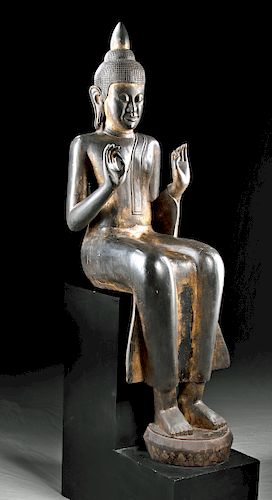Large 18th C. Cambodian Gilt Teak Seated Buddha
Lot 131
About Seller
Artemis Fine Arts
686 S Taylor Ave, Ste 106
Louisville, CO 80027
United States
Selling antiquities, ancient and ethnographic art online since 1993, Artemis Gallery specializes in Classical Antiquities (Egyptian, Greek, Roman, Near Eastern), Asian, Pre-Columbian, African / Tribal / Oceanographic art. Our extensive inventory includes pottery, stone, metal, wood, glass and textil...Read more
Categories
Estimate:
$24,000 - $36,000
Absentee vs Live bid
Two ways to bid:
- Leave a max absentee bid and the platform will bid on your behalf up to your maximum bid during the live auction.
- Bid live during the auction and your bids will be submitted real-time to the auctioneer.
Bid Increments
| Price | Bid Increment |
|---|---|
| $0 | $25 |
| $300 | $50 |
| $1,000 | $100 |
| $2,000 | $250 |
| $5,000 | $500 |
| $10,000 | $1,000 |
| $20,000 | $2,500 |
| $50,000 | $5,000 |
| $100,000 | $10,000 |
| $200,000 | $20,000 |
About Auction
By Artemis Fine Arts
Sep 26, 2019
Set Reminder
2019-09-26 10:00:00
2019-09-26 10:00:00
America/New_York
Bidsquare
Bidsquare : Exceptional Day 1: Antiquities & Asian Art
https://www.bidsquare.com/auctions/artemis-gallery/exceptional-day-1-antiquities-asian-art-4437
Day 1 of an important 2-day auction featuring exceptional, museum-worthy examples of Egyptian, Greek, Etruscan, Roman, Viking, Russian, Near Eastern, as well as Asian Art from China, Japan, Thailand, Vietnam, Burma and India. Artemis Fine Arts info@artemisfinearts.com
Day 1 of an important 2-day auction featuring exceptional, museum-worthy examples of Egyptian, Greek, Etruscan, Roman, Viking, Russian, Near Eastern, as well as Asian Art from China, Japan, Thailand, Vietnam, Burma and India. Artemis Fine Arts info@artemisfinearts.com
- Lot Description
Southeast Asia, northwestern Cambodia, ca. 18th century CE. A massive, skillfully carved, teak wood seated Buddha, his body covered in dark lacquer with gilt paint visible along his torso, cape, face, and ushnisha. His serene face gazes down at the viewer, his large, heavy eyelids almost completely closed in the classic Khmer style that persisted into the 18th century. He has hair with a prominent bun and, atop it, a pointed ushnisha, symbol of his enlightenment. His ears are large, with long, stretched earlobes, a reminder of his former life as the opulent Prince Siddhartha. He wears a sash diagonally across his torso and a cape, the back of which is carved and visible behind one shoulder and behind his legs. He is seated in a style known as "European", as if on a chair rather than with his legs crossed. This style entered Southeast Asia with European colonialism and is rare to see. His feet rest on a diminutive round pedestal without decoration. Size: 26" L x 18" W x 63" H (66 cm x 45.7 cm x 160 cm); 75" H (190.5 cm) on included custom stand.
The Buddha's hands are raised in a mudra that is particular to Southeast Asian Buddhism: "Pacifying the Ocean" or "Calming the Ocean", a variant of the Abhaya Mudra, the gesture of fearlessness, representing protection, peace, and dispelling fear. Here, his palms face outward, held chest high, with his forefinger and thumb touching in an additional reminder of peace. This gesture refers to an incident when Buddha stopped a flood. In Buddhist lore, he was traveling and entered a village that contained three fire-worshipping hermits. He requested a place to stay for the night and one of the hermits, Kasyapa, gave him a hut on the banks of a nearby river. Overnight, the river began to rise, threatening the hut. Buddha stopped the river's rise before the hermits and their followers, who instantly became his followers instead.
This graceful Buddha sculpture would have once adorned a temple or stupa; the European style of the legs indicates that it would have had an ornately carved throne. Imagine stepping from bright daylight into a darkened temple, seeing it surrounded by offerings of flowers and fruit, the gleaming focal point of its place of worship.
Provenance: private Boulder, Colorado, USA collection, acquired at Indochine Gallery, Boulder, Colorado, USA
All items legal to buy/sell under U.S. Statute covering cultural patrimony Code 2600, CHAPTER 14, and are guaranteed to be as described or your money back.
A Certificate of Authenticity will accompany all winning bids.
We ship worldwide and handle all shipping in-house for your convenience.
#148129Expertly restored to appear fully intact. Fine craquelure on surface, with much of the original pigment remaining. Gilt is worn but still present in many areas. Light wear commensurate with age.Condition
- Shipping Info
-
All shipping is handled in-house for your convenience. Your invoice from Artemis Gallery will include shipping calculation instructions. If in doubt, please inquire BEFORE bidding for estimated shipping costs for individual items.
-
- Buyer's Premium



 EUR
EUR CAD
CAD AUD
AUD GBP
GBP MXN
MXN HKD
HKD CNY
CNY MYR
MYR SEK
SEK SGD
SGD CHF
CHF THB
THB














